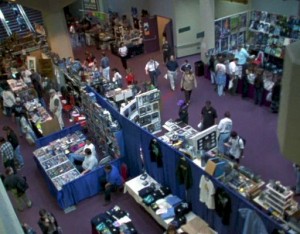 “Why would I want an old Star Trek calendar?”
“Why would I want an old Star Trek calendar?”
That was the question I pondered standing in the dealers’ room at my first con, way back in 1987. I’d only been a “Trekker” for about a year, and I’d had no idea there was so much stuff out there relating to my new enthusiasm. The convention was a modest but well-run affair—“Genesis Khan” (clever name, yes?), in Raleigh, North Carolina—without even one guest of honor, but its dealers’ room was amazing. Action figures, video cassettes, costumes, commemorative plates, trading cards, comic books, statuettes, books, records… and old calendars, one of which an eager dealer was trying to convince me to buy.
“It’s from 1979,” she told me (perhaps she assumed I couldn’t read the calendar’s front cover). She added, after a beat, “The year The Motion Picture came out” (perhaps she’d forgotten she was at a Star Trek convention—did anything else of note happen in 1979? Duh!). When I still didn’t jump at the chance, she made her final pitch: “Sometimes people take old calendars around to conventions and collect the stars’ autographs.”
That comment electrified me. “Trekkers” collected signatures, too? I didn’t buy the calendar—four dollars was too rich for this eighth-grader’s blood—but I had a brief vision of going from con to con, hobnobbing with William Shatner and Leonard Nimoy, gathering wonderfully personalized inscriptions. How cool would that be?!
Nearly three decades later, I am lucky enough to have a few Trek autographs (I’ve mentioned my Takei and Koenig sigs before; I’ve also got Mark Lenard, Marina Sirtis, and even—ta da!—Sir Patrick Stewart, thanks for asking), but I never became a heavy-duty Trek autograph hound.
In fact, compared to some people, I never became a really serious Star Trek collector.
 That’s not to say, of course, that I don’t have plenty of Trek stuff (and assorted other genre stuff, too—some of the “toys” on my desk at work are illustrated here). I own the Original Series and TNG, Deep Space Nine and all eleven films. I have CDs of most of the movie soundtracks. My shelf of Trek books is smaller than it in its heyday, but what with episode guides, Shatner and Nimoy’s memoirs, a trivia game book, and a handful of fiction (including—shameless plug alert—my own appearance in Star Trek: Strange New Worlds II—still available as an e-book, makes a great gift), I don’t lack for Trek-related reading material. Every December I look forward to breaking out my Hallmark Star Trek Christmas ornaments, and from time to time I squeeze the plush tribble stashed in my nightstand to hear its electronic chirp.
That’s not to say, of course, that I don’t have plenty of Trek stuff (and assorted other genre stuff, too—some of the “toys” on my desk at work are illustrated here). I own the Original Series and TNG, Deep Space Nine and all eleven films. I have CDs of most of the movie soundtracks. My shelf of Trek books is smaller than it in its heyday, but what with episode guides, Shatner and Nimoy’s memoirs, a trivia game book, and a handful of fiction (including—shameless plug alert—my own appearance in Star Trek: Strange New Worlds II—still available as an e-book, makes a great gift), I don’t lack for Trek-related reading material. Every December I look forward to breaking out my Hallmark Star Trek Christmas ornaments, and from time to time I squeeze the plush tribble stashed in my nightstand to hear its electronic chirp.
What’s in Your Barn?
So what does my collecting, modest though it is, have to do with “The Most Toys?”
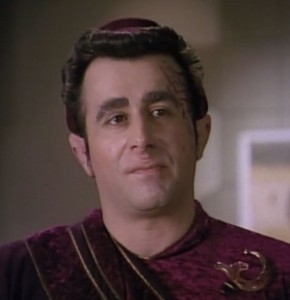 In its first act, this episode seems like it might be, as was the previous week’s “Hollow Pursuits,” another satire of sci-fi fans. After all, the villain of the piece, Kivas Fajo (played by Saul Rubinek), is an inveterate collector, and collecting is a large part of many fans’ activities. Fajo, of course, is also a thief, which I don’t believe most fans are; and he specializes in the expensive and unique to a degree I don’t think most fans can. But I know I can relate, on some level, to his desire for the next “really cool” thing, and I confess I’ve shared, at times, his belief that security and worth can be found in what I own.
In its first act, this episode seems like it might be, as was the previous week’s “Hollow Pursuits,” another satire of sci-fi fans. After all, the villain of the piece, Kivas Fajo (played by Saul Rubinek), is an inveterate collector, and collecting is a large part of many fans’ activities. Fajo, of course, is also a thief, which I don’t believe most fans are; and he specializes in the expensive and unique to a degree I don’t think most fans can. But I know I can relate, on some level, to his desire for the next “really cool” thing, and I confess I’ve shared, at times, his belief that security and worth can be found in what I own.
I suspect most people have a streak of Fajo in them, frankly—if not about genre toys and trinkets, then about something else. The cars we drive, the clothes we wear, the computers we use… The temptation to identify ourselves with what we own, even to idolize it, is nothing new. Qohelet the Teacher gained a wisdom Fajo never possessed, for he ultimately realized his “great possessions, more than anyone who had been before [him] in Jerusalem,” were only so much “vanity and a chasing after wind” (Ecclesiastes 2.7, 11). And Jesus warned us that “life does not consist in the abundance of possessions” (Luke 12.15). He told a memorable parable about a wealthy fool who stored up all kinds of treasure for himself, building ever-bigger barns in order to store all his stuff, only to find that his riches couldn’t make him “rich toward God” (12.16-21).
I can’t claim to have mastered materialism’s pull in my life. Every time I catch myself muttering about “so much junk” in my house, I feel a stab of guilt. Everyone should have such problems. How dare I regard what I own with contempt, when so many have so little? How dare I even consider adding even more, instead of sorting and simplifying?
The things we own can, if we’re not careful, keep us from recognizing our dependence upon God. That’s why Jesus commands us to store up treasures not on earth but in heaven, by living a life of prayer and self-denial and giving rather than getting (see Matthew 6.1-20). Our hearts will be where our treasure is, he tells us (6.21)—and, as Saint Augustine knew, our hearts can only ever find peace and joy when they are with the God who fashioned them.
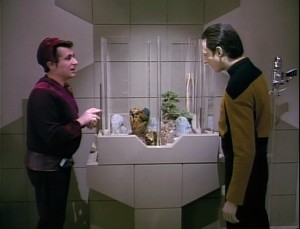 In the last scene of Act I, Fajo takes Data, his newest acquisition, on a tour of his collection, one priceless inanimate object after inanimate object (well, one animate object, the lapling—a painfully obvious hand puppet from a production standpoint, but thematically important as further proving Fajo’s selfish objectification of other living beings), gathered and preserved for Fajo’s “appreciation” alone. In the first scene of Act II, however, we watch Geordi and Wesley “tour” Data’s quarters, regarding the few personal possessions of their presumed fallen colleague and friend. Each object accrues meaning from Data’s interpersonal relationships: the Shakespeare volume given him by Captain Picard; the deck of cards and poker chips used in the crew’s weekly game; the medals—“some of Starfleet’s highest honors,” says Wes—Data earned in the service of others; and (reprising its appearance from “The Measure of a Man”) the holographic portrait of Tasha Yar. Even the unfinished painting on Data’s easel isn’t really only about its painter: Data took up the hobby as part of his continuing quest to connect with the human race. Viewing this transition from Act I to Act II on home video—without the intrusion of commercials trying to sell us more stuff—viewers can appreciate the clear contrast. Fajo views material objects as an end in and of themselves, existing solely for his benefit. The Enterprise crew knows that material objects matter only when they enhance life together, only when they can be freely given and received.
In the last scene of Act I, Fajo takes Data, his newest acquisition, on a tour of his collection, one priceless inanimate object after inanimate object (well, one animate object, the lapling—a painfully obvious hand puppet from a production standpoint, but thematically important as further proving Fajo’s selfish objectification of other living beings), gathered and preserved for Fajo’s “appreciation” alone. In the first scene of Act II, however, we watch Geordi and Wesley “tour” Data’s quarters, regarding the few personal possessions of their presumed fallen colleague and friend. Each object accrues meaning from Data’s interpersonal relationships: the Shakespeare volume given him by Captain Picard; the deck of cards and poker chips used in the crew’s weekly game; the medals—“some of Starfleet’s highest honors,” says Wes—Data earned in the service of others; and (reprising its appearance from “The Measure of a Man”) the holographic portrait of Tasha Yar. Even the unfinished painting on Data’s easel isn’t really only about its painter: Data took up the hobby as part of his continuing quest to connect with the human race. Viewing this transition from Act I to Act II on home video—without the intrusion of commercials trying to sell us more stuff—viewers can appreciate the clear contrast. Fajo views material objects as an end in and of themselves, existing solely for his benefit. The Enterprise crew knows that material objects matter only when they enhance life together, only when they can be freely given and received.
If this insight sounds familiar to Christians, it’s because the early church knew it, too: “All who believed were together and had all things in common; they would sell their possessions and goods and distribute the proceeds to all, as any had need… And day by day the Lord added to their number those who were being saved” (Acts 2.44-45, 47). I’m not claiming there’s a direct, causal connection between the primitive church’s economic practices and its growth—but Luke’s undoubtedly idealized portrait of the apostolic community may still offer insight to those congregations and denominations struggling with decline. To what extent might the church’s lack of growth be linked to its grip on its possessions? How might we open ourselves anew to the Spirit’s activity if we acted as though we really and truly believed that, instead of having possessions ourselves, we the church are the possession of God?
Of Data and Daniel
For all its critique of the materialistic mentality of acquisition, however, “The Most Toys” is, as so much of the best Star Trek is, a morality play. Larry Nemecek, in his TNG Companion, describes it as an “interesting story from a spec script that pushed Data to the brink of murder for a logical reason.” I wonder how much of the spec script made it to the screen; judging only from Nemecek’s comment, I’d be willing to bet a good deal did. I remember being surprised by the episode’s ending when it first aired, but I’d forgotten how inexorably it builds toward that conclusion.
 As Fajo’s captive, Data struggles to hold on to his identity, while Fajo attempts to remake Data in his own image. Data refuses to wear the clothing Fajo provides—until Fajo dissolves Data’s Starfleet uniform with acid, banking on the fact that “decency is the rule of your Starfleet training.” Data refuses to sit in the chair where Fajo wants him to sit—until Fajo threatens the life of Varria (Jane Daly) with the “more than lethal… vicious” Varon-T disruptor. When Fajo wants Data to interact with Palor Toff (Nehemiah Persoff), he absolutely refuses, remaining resolutely mute and motionless, even allowing Fajo to knock him to the floor.
As Fajo’s captive, Data struggles to hold on to his identity, while Fajo attempts to remake Data in his own image. Data refuses to wear the clothing Fajo provides—until Fajo dissolves Data’s Starfleet uniform with acid, banking on the fact that “decency is the rule of your Starfleet training.” Data refuses to sit in the chair where Fajo wants him to sit—until Fajo threatens the life of Varria (Jane Daly) with the “more than lethal… vicious” Varon-T disruptor. When Fajo wants Data to interact with Palor Toff (Nehemiah Persoff), he absolutely refuses, remaining resolutely mute and motionless, even allowing Fajo to knock him to the floor.
Data’s resistance to Fajo reminded me of Daniel and his friends in the Old Testament. Among the citizens of Jerusalem deported to Babylon when King Nebuchadnezzar besieged the city, Daniel and the three other young men (somewhat ironically, best known to us by their Babylonian-imposed names of Shadrach, Meshach, and Abednego) remained loyal to the God of Israel even in the face of pressure to acculturate into life at the Babylonian royal court. They observed a kosher, vegetarian diet, yet “appeared better and fatter than all the young men who had been eating the royal rations” (Daniel 1.15). Daniel refused to stop praying to God, a transgression of a royal decree that earned him his famous overnight stay in a lions’ den, from whose hungry mouths God saved him (see Daniel 6). Shadrach, Meshach, and Abednego also loyally worshiped God rather than the king, boldly declaring that even if God chose not to deliver them from the fiery furnace, they would not worship false deities (see 3.16-18). Like captive Data aboard Fajo’s ship, these exiled Hebrew youth could enjoy the best of material living in the Babylonian court—like Data, they could be “catered to, fawned over… cared for as never before,” their “every wish fulfilled”—but they turn their back on such temporal gain in favor of spiritual blessing. They remain obedient to God’s covenant with Israel, observing the laws and traditions that mark Israel as God’s “treasured possession out of all the peoples… a priestly kingdom and a holy nation” (Exodus 19.5-6).
Data doesn’t act out of religious conviction, but he does choose to hold on to the unique identity conferred on him by his creator, an identity he has reinforced through his service in Starfleet. He will not, as Fajo wants him to, “adjust [his] program to accept reality” (reality as Fajo defines it).
Of Data and Duty to Neighbor
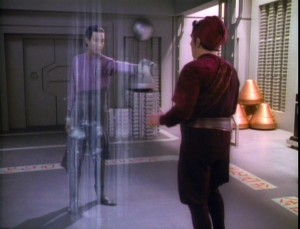 Data does run up against his programming’s limits when Fajo murders Varria. Data has been, he says, “designed with a fundamental respect for life in all its forms, and a strong inhibition against causing harm to living beings.” At the same time, he is “programmed with the ability to use deadly force in a cause of defense.” Fajo’s actions make it clear that, as laughable as he is in some ways, he is serious in his threat to kill again unless Data complies with his wishes: “There’s always another Varria.” Brent Spiner proves his excellence as, through subtle facial expressions, he conveys Data’s internal struggle before declaring, “I cannot allow this to continue.” And Data pulls the trigger.
Data does run up against his programming’s limits when Fajo murders Varria. Data has been, he says, “designed with a fundamental respect for life in all its forms, and a strong inhibition against causing harm to living beings.” At the same time, he is “programmed with the ability to use deadly force in a cause of defense.” Fajo’s actions make it clear that, as laughable as he is in some ways, he is serious in his threat to kill again unless Data complies with his wishes: “There’s always another Varria.” Brent Spiner proves his excellence as, through subtle facial expressions, he conveys Data’s internal struggle before declaring, “I cannot allow this to continue.” And Data pulls the trigger.
I regret the creative team arranged matters so that Data shoots Fajo at the exact instant that, unbeknownst to him, the Enterprise’s transporter beam is locking onto him and whisking him away. Watching Data wrestle with the consequences of having taken a life—though not an innocent one—would have been fascinating. Would killing Fajo have been morally justified?
Jesus spoke what I read as absolute prohibitions against killing. He called his followers, so far from resisting evildoers, to turn the other cheek, and taught that anger is, in God’s eyes, equivalent to murder (see Matt. 5.21, 38-41). He warned that those who live by the sword will die by it, and preached that we must love and pray for our enemies that we may be children of the Father in heaven (see Matt. 26.52; 5.43-45). But as you already know, quoting Bible verses, even red-letter words from Jesus’ own lips, don’t settle any argument. While I don’t think Christians generally have any business taking life and death into their own hands, does that mean there are never situations in which faithfulness to God and love of our neighbor mean using force, even deadly force? Are there never times when Christians who are in a position to stop a manifest threat to innocent life must say, with Data, “I cannot allow this to continue?”
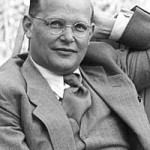 Sixty-eight years ago this week (April 9), Protestant theologian and pastor Dietrich Bonhoeffer was hanged by the Nazis at Flossenburg for his part in a conspiracy to assassinate Adolf Hitler. (Americans liberated the camp 11 days later.) While it is true he wasn’t planning to be the one to pull the trigger, Bonhoeffer actively aided resistance to Hitler, clandestinely conveying information to the conspirators from his work in the Nazi Office of Military Intelligence. A man of great learning and great faith, Bonhoeffer was of course aware of the conflict between Jesus’ call to peace and his support of what all involved anticipated would be a violent and bloody coup. The Internet Encyclopedia of Philosophy summarizes Bonhoeffer’s argument for his actions, from his book Ethics, in this way:
Sixty-eight years ago this week (April 9), Protestant theologian and pastor Dietrich Bonhoeffer was hanged by the Nazis at Flossenburg for his part in a conspiracy to assassinate Adolf Hitler. (Americans liberated the camp 11 days later.) While it is true he wasn’t planning to be the one to pull the trigger, Bonhoeffer actively aided resistance to Hitler, clandestinely conveying information to the conspirators from his work in the Nazi Office of Military Intelligence. A man of great learning and great faith, Bonhoeffer was of course aware of the conflict between Jesus’ call to peace and his support of what all involved anticipated would be a violent and bloody coup. The Internet Encyclopedia of Philosophy summarizes Bonhoeffer’s argument for his actions, from his book Ethics, in this way:
The demand for responsible action in history is a demand no Christian can ignore. We are, accordingly, faced with the following dilemma: when assaulted by evil, we must oppose it directly. We have no other option. The failure to act is simply to condone evil. But it is also clear that we have no justification for preferring one response to evil over another… We must not refuse to act on our neighbor’s behalf, even violently, for fear of sin. To refuse to accept guilt and bear it for the sake of another has nothing to do with Christ or Christianity… The risk of guilt generated by responsible action is great and cannot be mitigated in advance by self-justifying principles. There is no certainty in a world come of age. No one, in other words, can escape a complete dependency on the mercy and grace of God.
Few of us, God willing, will find ourselves facing the kind of dire decision that Bonhoeffer faced. But none of us can avoid the call to responsible action of which Bonhoeffer spoke. As Martin Luther wrote in his Small Catechism, God’s commandment against murder is not only a negative prohibition—“Thou shalt not kill”—but also a positive injunction: “We should fear and love God that we may not hurt nor harm our neighbor in his] body, but help and befriend him in every need and danger of life and body.”
What needs and dangers do those around us—in our neighborhoods, in our schools and workplaces, in our congregations, in our nation and world—face that we, striving to live as responsible disciples of Jesus Christ, simply cannot allow to continue? And what are we willing to do and to risk, trusting in God’s mercy and grace, to make them stop?
Scripture quotations are from the New Revised Standard Version.

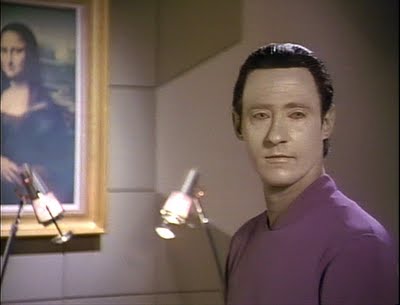
Fajo should marry a non-geek. That would solve his ‘collecting’ problem (hording).
Great stuff concerning Data’s moral dilemma at the end. I wish they hadn’t pulled their punch and allowed him to kill Fajo, as he decided. That would have opened Data to new depths of human existence: conscience and remorse. My secret wish is for every good episode to have a follow-up, a la Family. The main TNG characters are developed so well, I would love to see them dealing with the big events.
Great marital advice for Fajo, Mickey! And, yes, the line between “collecting” and “hoarding” is often a fine one, isn’t it?
We didn’t see the TNG characters have to face the repercussions of their actions and choices in subsequent weeks until much later in the series. Had this been a fifth or sixth year story, I think the writers would have been brave enough to let Data succeed. Alas, what might have been.
Thanks for reading and commenting, as ever! More to come… eventually…!
I was at the same 1987 con in Raleigh. I was only 15 years old and it was my first as well. Mark Lenard was the top guest, but the highlight for me was the TNG preview, as this was still a couple of weeks before the premiere. I’ve been searching for my program for years, but haven’y been able to find it.
A little research shows that there were more than one Genesis Khan in 1987. I was at the September con, but there was also one in May…
Aha! I knew there were two, but I had always thought GKI was the previous year. Thanks!
Hi, Greg! I remember the Mark Lenard presentation – all he wanted to do (as I recall) was talk about his role in the “Planet of the Apes” TV series! But he was very nice when I got his autograph. I was the same age you were, 15.
I remember complaining to someone in the dealers’ room that I thought the NCC-1701-D was the ugliest ship I’d ever seen. (Maybe it was you, who knows?) Now I have more than one desktop models of it.
I also remember Rick Berman’s TNG preview. When he told us we were gonna get a “big bad” so mean and scary even the Klingons joined the Federation, the hall erupted in a loud “oooh” of anticipation. And then we got the Ferengi. 😉
Great to cross cyberpaths with you! Thanks for reading and commenting!